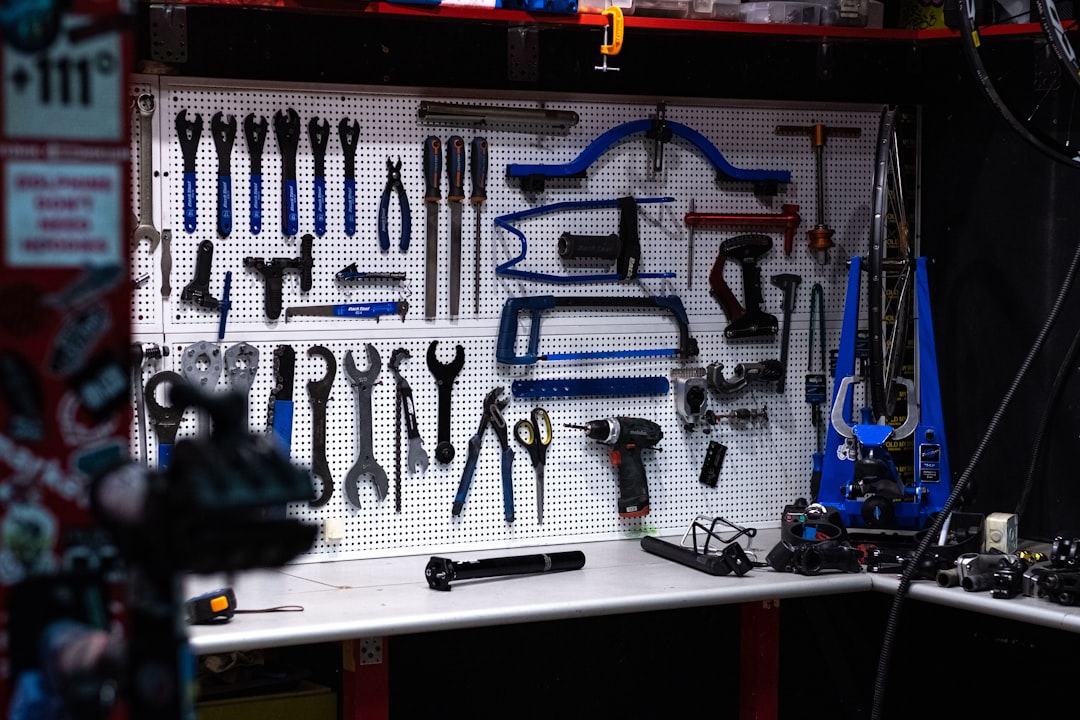

Engage prospects with a scan and streamline customer engagement with FREE QR code marketing tools by Sona – no strings attached!
Create a Free QR CodeFree consultation

No commitment

Engage prospects with a scan and streamline customer engagement with FREE QR code marketing tools by Sona – no strings attached!
Create a Free QR CodeFree consultation

No commitment
QR codes have evolved from a novelty into a vital tool for linking physical assets with digital processes. Auto body shop equipment suppliers often lose engagement and miss tracking opportunities by relying on paper-based documentation or static displays. QR codes modernize customer engagement, streamline buying processes, and connect offline equipment to online information like additional product info, helping turn anonymous showroom traffic into actionable insights by tracking which products draw interest and driving real-time buyer engagement.
By integrating QR codes, auto body shop equipment suppliers deliver instant product information, capture buyer intent signals, and offer seamless access to manuals, financing options, and rental services. These touchpoints elevate the customer experience and help suppliers build richer first-party data for improved lead quality and campaign attribution, addressing pain points such as missed high-value prospects and incomplete records.
This guide provides strategies for leveraging QR codes in the auto body equipment sector, from campaign setup to advanced tracking. With real-world examples and industry best practices, you will see how data-driven QR code deployments unlock revenue potential and measurable ROI, closing every gap in the prospect journey.

For many equipment suppliers, the disconnect between in-person interest and digital follow-up leads to lost opportunities, especially when valuable prospects browse product lines without ever filling out a form. QR codes bridge that gap by turning every physical asset and printed material into a digital entry point. When a buyer scans a code on a frame machine, welder, or paint booth, they can jump directly to specs, comparison tools, or a request-a-quote form, while your team captures context and intent signals for timely follow-up in the CRM.
QR codes also replace outdated analog workflows that stall the sales cycle. Instead of paper brochures that go out of date or manual sign-up sheets that never make it to the database, codes drive instant actions like watching demo videos, submitting financing applications, or reserving a rental unit. This shift not only enhances customer experience but also prevents data loss, shortens response times, and creates a consistent, trackable path from first touch to revenue.
Modern QR tools make this workflow seamless. Instead of anonymous foot traffic and unmeasured interest, you get a clear view of who is engaging, on which products, and with what intent. That intelligence translates into faster responses, more relevant follow-ups, and a repeatable method for revenue growth.
Auto body equipment sales often involve multiple stakeholders across a long consideration window, from shop owners and lead technicians to finance managers and procurement teams. Without a way to capture and connect offline interest to digital actions, promising prospects remain invisible. A technician may scan specs at a demo or review setup instructions on-site, but if that action is not tracked, you miss a crucial moment to qualify interest and progress the deal.
QR codes solve this by making every physical touchpoint interactive. Each scan can trigger a high-value next step like requesting a quote, downloading a spec sheet, or launching a financing pre-qualification. Dynamic QR codes keep printed materials current even as offers, models, or inventory change. You preserve your investment in signage and catalogs while gaining real-time analytics that guide retargeting, budget allocation, and inventory decisions.
By treating every scan as a measure of intent, suppliers gain the ability to segment audiences, prioritize leads, and provide richer support at every stage of the buying cycle.

QR codes are flexible enough to power a range of high-impact workflows for equipment suppliers. Selecting the right format ensures the scan leads to the most relevant action for each context.
For long sales cycles and frequently updated information, dynamic QR codes are the standard. They allow you to change destinations without reprinting while capturing granular analytics by product, location, or campaign. Static codes are fine for evergreen content like a universal service line or a basic company profile, but dynamic codes deliver the flexibility and data most suppliers need.

The best QR deployments meet the buyer exactly where curiosity or urgency is highest. By mapping codes to existing physical touchpoints, you convert passive interest into measurable engagement and reduce the burden on staff to capture details manually.
A practical path to quick wins starts with showroom tags and trade show signage, then expands to catalogs and post-sale materials. This sequence captures interest across the funnel, from first look to ongoing service, and creates a steady stream of structured data to improve forecasting and territory planning.

Suppliers can apply QR codes across the entire lifecycle, from awareness to purchase to support and expansion. Each use case replaces friction with immediacy and visibility.
When combined with dynamic destinations and CRM workflows, these use cases accelerate funnel movement and enable smarter remarketing. You stop losing leads to slow follow-up, outdated collateral, or missing records.
Every scan contains context that can make your outreach more relevant. By deploying multiple codes across different touchpoints and journey stages, you create clean audience segments that align with real behavior rather than assumptions.
This segmentation strategy turns an unstructured stream of showroom traffic into a prioritized pipeline. You will know which offers attract buyers quickly, where to invest in inventory, and how to tailor outreach for higher response rates.
QR codes act as connective tissue across channels that have traditionally been hard to measure. By attaching a scan path to each offline asset, you transform static materials into performance marketing tools that enrich your data and improve customer experience.
With Sona QR as your management layer, you can generate codes, update destinations, monitor performance, and sync scan data with your CRM and ad platforms. The result is a connected customer journey with fewer dead ends and richer attribution across channels. For more industry context, see automotive QR solutions.
Launching a QR initiative is straightforward when you follow a disciplined process. Begin with a single workflow, then expand to multiple placements and use cases as you learn what resonates with your buyers.
Start by aligning a specific business outcome to a measurable scan action. For example, if your priority is to grow financed deals, put QR codes on pricing displays that open a pre-qualification form and measure scan-to-approval rates by product line. Keep the experience lightweight, mobile-first, and tailored to the environment where the scan occurs. Start creating QR codes for free.
Decide exactly what you want the scan to accomplish. Common goals include capturing financing applications, increasing tutorial video views for complex equipment, registering new equipment for warranty, or driving rental reservations during seasonal peaks.
Tie the scan action to a single conversion event on the landing page. If you need multiple options, present them with clear visual hierarchy so the primary action remains obvious. Then define success metrics such as scans per day per placement, scan-to-form-start rate, form completion rate, and sales-qualified leads generated.
Select dynamic codes for any campaign that requires flexibility, analytics, or retargeting. Dynamic codes let you update destinations without reprinting, add UTM parameters, and capture detailed scan data like location and device. Static codes work for evergreen destinations that never change, but they limit tracking and optimization.
If you are running trade show campaigns, seasonal promotions, or frequently updated catalogs, dynamic codes are the safest choice. They enable continuous improvement and protect your printing investment.
Create visually branded codes with a clear frame, your logo, and a high-contrast palette that stands out on busy backgrounds. Add a benefit-driven call to action such as Scan for a 90-second demo or Scan for instant financing. Test code size and placement on glossy materials, curved surfaces, and from typical viewing distances.
Validate scannability under real conditions. Check multiple devices, camera apps, lighting environments, and angles. Confirm that the landing page loads fast, is mobile responsive, and limits required fields so users can complete tasks quickly.
Start with locations that see steady traffic and carry high buying intent. Priority placements include showroom equipment tags, pricing stands, catalogs, trade show booths, and crate labels. Map each placement to the appropriate destination, for example a pricing display that opens financing, or a crate label that opens a setup guide.
Roll out in phases so you can compare performance by channel and iterate. Use different codes for each placement and surface the code ID on your reporting dashboard so sales and marketing can see where engagement originates.
Watch scan-to-conversion ratios in real time and compare by product, location, and time of day. Identify weak placements or CTAs and run A/B tests on headlines, button copy, or video thumbnails. Use UTM parameters to attribute scans to specific campaigns, then sync insights to your CRM to refine lead scoring and outreach.
As you scale, create a centralized library of codes within Sona QR, enforce design templates, and set naming conventions that make analysis easy. The goal is to build a repeatable engine that turns every surface into a measurable, conversion-ready touchpoint.
Many suppliers struggle to connect offline engagement to closed deals. QR-enabled analytics and CRM integrations close this gap by carrying context through the funnel and proving which assets generate pipeline and revenue.
With Sona QR and Sona.com, you move beyond basic scan counts. You capture time, device, channel, and location data, then link those signals to known contacts and accounts. You can see which equipment categories generate the most qualified interest, how event traffic compares to in-store engagement, and where to focus inventory and sales coverage for the highest yield.
This level of insight transforms QR codes from a convenience into a performance channel. You will not only see who is engaging, but also which touchpoints lead to real conversations, quotes, and orders.
QR programs deliver the most value when they are consistent, data-rich, and easy for staff to promote. The following practices help you scale with confidence while improving both customer experience and measurement.
Creative deployments can extend impact without major cost. For instance, place a QR code on rental invoices to rebook or transition to a purchase, and add a code to service stickers so technicians can book maintenance or order parts during a shift.

Suppliers are already using QR code technology to shorten research cycles, capture more leads, and streamline support. The examples below illustrate how small changes in placement and messaging produce outsized results.
These examples demonstrate how QR codes convert moments of curiosity or need into measurable actions and better customer outcomes. By tailoring each destination to the user’s context, you reduce friction and create clarity at the exact moment it matters.
To maximize ROI, treat QR codes as a strategic layer in your sales and service process, not as a one-off tactic. The strongest programs pair excellent placements with clear CTAs, mobile-first destinations, and rigorous tracking that closes the loop from scan to revenue.
For auto body shop equipment suppliers, a well-designed QR strategy turns static equipment and printed materials into engines for data-driven growth. Each scan connects a physical interaction to a digital signal you can measure and act on. By integrating dynamic codes, clear CTAs, and an analytics layer like Sona QR and Sona.com, you can resolve the lost opportunities caused by anonymous traffic and incomplete records, then scale a seamless buyer experience across every touchpoint. Start creating QR codes for free.
QR codes have revolutionized the auto body shop equipment suppliers industry by transforming static product information into dynamic, measurable engagement opportunities. Whether it’s streamlining equipment access, enhancing customer support, or enabling real-time inventory updates, QR codes replace outdated manual processes with instant, mobile-friendly interactions that deliver actionable insights and improved operational efficiency. Imagine technicians instantly accessing detailed manuals or warranty info with a simple scan—saving time and reducing errors on the shop floor.
With Sona QR, you can create dynamic, trackable QR codes in seconds, update campaigns or equipment data without costly reprints, and link every scan to tangible business outcomes. This means better customer experiences, faster service, and clearer ROI from your QR initiatives. Start for free with Sona QR today and turn every scan into a seamless connection between your equipment, your customers, and your bottom line.
Top auto body shop equipment suppliers leverage QR code technology to connect physical assets with digital information, improving customer engagement and tracking.
Select equipment based on essential needs like frame machines, welders, and paint booths, and use QR codes on products to access detailed specs, comparisons, and buyer resources to make informed decisions.
Essential equipment includes frame machines, welders, paint booths, alignment systems, diagnostic tools, and tools with QR codes for easy access to product information and support.
Best deals can be found by scanning QR codes on showroom displays, pricing sheets, and point-of-sale signage that link to financing options, rental services, and special offers.
Use QR codes on machines and service stickers to access maintenance schedules, service libraries, and to trigger service tickets for faster resolution and upsell opportunities.
QR codes transform physical touchpoints into interactive digital experiences, capturing buyer intent, providing real-time data, and enabling better lead qualification and follow-up.
QR codes offer instant access to product videos, manuals, financing forms, and rental reservations, enhancing buyer experience and capturing actionable insights for sales teams.
Common formats include web links to product pages, vCards for contact info, forms for registrations and bookings, Wi-Fi access codes, and app download links.
Deploy QR codes at high-intent touchpoints like showroom tags and catalogs, design clear CTAs, use dynamic codes for flexibility, monitor analytics, and integrate data with your CRM.
Use platforms like Sona QR to track scans by product and location, measure engagement metrics, integrate with CRM systems, and analyze scan-to-lead conversion rates and revenue impact.
Assign unique codes per asset, add UTM parameters, automate follow-up communications, train staff to promote scanning benefits, and connect scans to lead scoring and nurturing.
QR codes turn physical assets and printed materials into digital entry points, capturing buyer actions and intent signals for timely CRM follow-up and reducing lost opportunities.
Examples include showroom displays linking to comparison videos, trade show codes for targeted follow-up, warranty registration via QR stickers, and training content access through equipment codes.
By creating unique codes per journey stage, tagging scans by product and role, tracking location and timing, and syncing data with CRM and ad platforms for targeted retargeting.
Define clear objectives, choose dynamic or static codes, design for scannability, deploy in high-impact locations, and monitor and optimize performance using analytics.
QR codes connect offline assets like brochures and trade show materials with digital channels, enabling measurable customer journeys and enriched data across platforms.
Ensure high contrast, adequate size, quiet space, and test scanning on glossy, curved, and various lighting conditions to maintain visibility and functionality.
Yes, QR codes can link directly to financing calculators, pre-qualification forms, and rental reservations, speeding up buyer decisions and capturing intent signals.
Avoid vague CTAs, linking to generic pages, poor code placement, lack of tracking integration, and failing to automate follow-up based on scan data.
Use Sona QR's trackable codes to improve customer acquisition and engagement today.
Create Your FREE Trackable QR Code in SecondsJoin results-focused teams combining Sona Platform automation with advanced Google Ads strategies to scale lead generation

Connect your existing CRM

Free Account Enrichment

No setup fees
No commitment required

Free consultation

Get a custom Google Ads roadmap for your business






Launch campaigns that generate qualified leads in 30 days or less.
